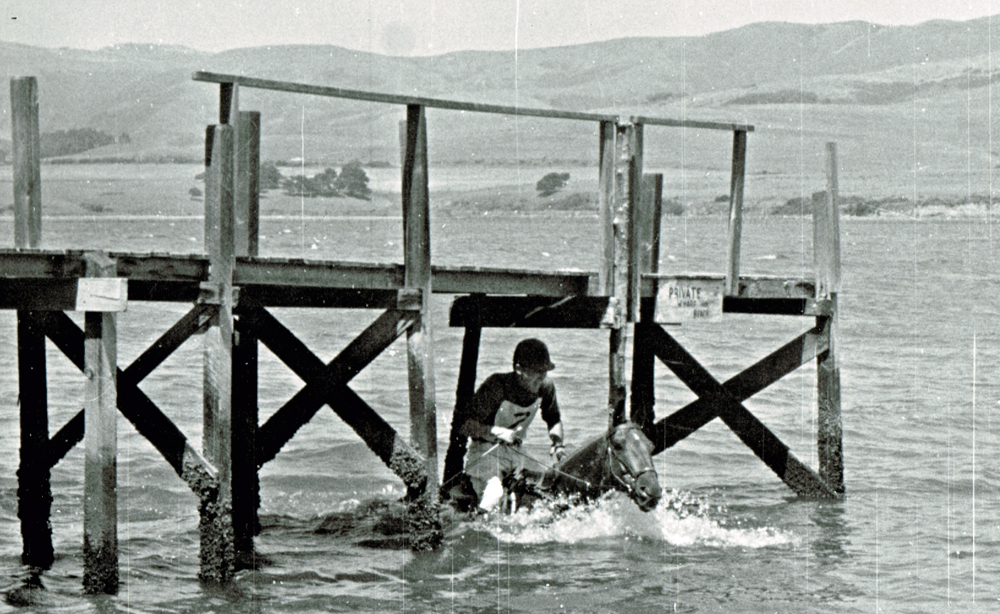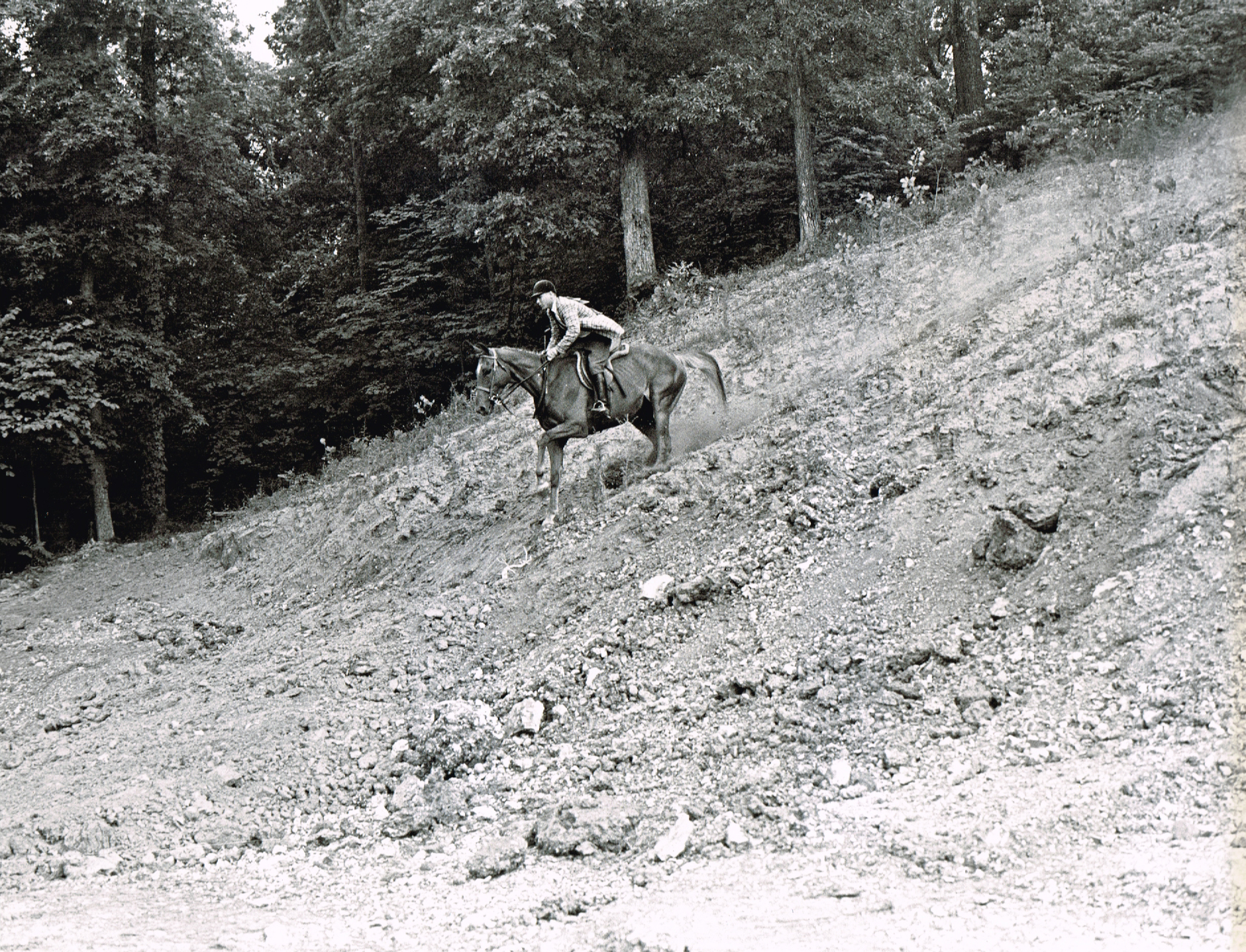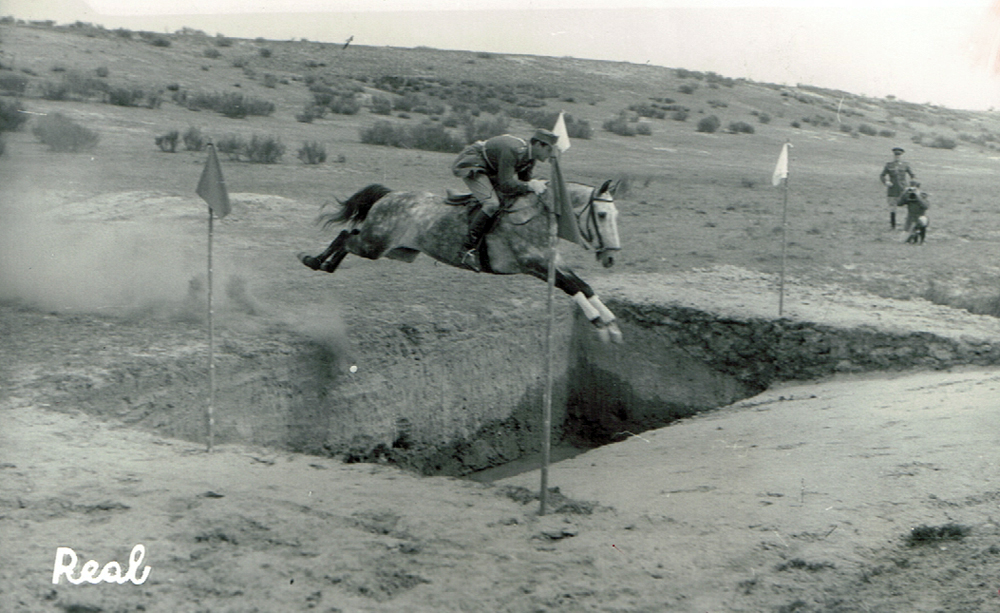If you’re at all worried about walking the course for an upcoming competition, just remember what courses looked like 60 years ago. Flipping though issues of the Chronicle published in the 1960s reveals some truly unbelievable questions on course.
The Aug. 31, 1962, issue included a report on the Inverness Two-Day Event in California. The event was described as a “prepatory meet designed to prepare horses and riders pointing toward the Wofford Cup trials at Pebble Beach.” The report included this amazing photo of the water jump, taken by Tony Vacek and captioned simply “Ernest Simard II on Paddy Boals at one of the obstacles in the cross-country”…

Ernest Simard II on Paddy Boals negotiate the water jump on cross-country at the Inverness Two-Day Event in California in 1962. Tony Vacek Photo
The article said the course didn’t “lend itself to a true galloping course, but packed into the 2 miles of cross-country, following 3 miles of up-and-down roads and trails, were two mighty interesting obstacles built to test the boldness and cleverness of horse and rider.”
The water jump was on of those, and it was Fence 3 on course. “The cross-country led along the left side of the valley to the beach where obstacle No. 3 consisted of going out into the bay alongside a pier and passing underneath it between the last sections of pilings, and thence back to the shore.
“Whether the horse waded belly deep or swam depended on his size as well as his mood!”
The course description also included “an overturned dinghy 3 to 4 feet in height and 7 feet wide,” and “a heavy post and rail fence at the top of a slide into a stream with another post and rail fence out of the water.”
Then, in the Aug. 27, 1966, issue of the Chronicle, there’s this photo published with simply a caption and no accompanying story…
ADVERTISEMENT

Ron Burton on Sea Breeze negotiating the slide in the Handy Hunter Working class. They won the third place ribbon. Chronicle File Photo
The caption reads, “Ron Burton on Sea Breeze negotiating the slide in the Handy Hunter Working class. They won the third place ribbon.” The show was the Valley Hunter Show in Valley Park, Missouri.
Can you imagine this hillside in a handy hunter class of today?
This last photo didn’t appear on a course in competition (thankfully!) but it’s worth highlighting for its sheer insanity.

A Spanish Army Riding School student jumps a ditch that was part of the final three-day event exam for second-year students.
The article it ran with was in the Sept. 14, 1962, issue of the Chronicle about the Spanish Army Riding School. This ditch was part of the final three-day event exam of the second-year students.
Here’s the article about the school, which must have turned out fearless and skilled horsemen…
“The ‘School’ has always strived to be a superior institution where officers from all branches of the army could perfect their riding, and eventually give the ‘Spanish Style’ a place in international competition. This could only be accomplished through excellent instruction, concentrated effort, and plenty of willingness on all sides (the horses included).
“At first a one year course was considered sufficient; but experience proved this theory wrong. In a year’s time the student remained rigid, unrelaxed in their adjustments to the School’s perfectionist instruction. They evidently needed a second year in which to ‘loosen up’ and gain confidence in themselves; they had to be able to apply their training to several different types of horses. For this reason, the School created a second year course for the selected students of the first year. This also gave an opportunity to spread out a rather crowded training program, leaving the more difficult phases for the second year. Some of these phases were the preparation of race horses, polo, and three-day events, which all call for a more experienced and self-confident rider.
ADVERTISEMENT
“When I say all the more difficult phases were left for the second year student, I omitted probably the most impressive feat of the Spanish Army Riding School: ‘las cortaduras.’ This is reserved for the first year students, and for a very good reason: it separated the men from the boys. ‘Las cortaduras,’ meaning literally ‘the cuts,’ or ‘drop-offs,’ are almost vertical slopes of about twelve meters in height, which the horses, with their somewhat apprehensive first year students, have to negotiate each May. I cannot say that I whole-heartedly agree with what usually terminates in a mass of broken bones on the riders’ part, but I must admit that if accomplished unhurt, it makes one feel as if nothing is insurmountable on horseback. One can be sure, however, that after May, a class of twenty has been temporarily reduced to one-third of its size. The event is witnessed by visiting members of foreign teams, as it coincides with the international jumping competition in Madrid, and by several others; all agree that Spanish riders are of the most daring sort.
“There is no phase of equitation that has not been attempted by the School. The students are even prepared in elementary veterinary medicine and stud management. For a while there was a stud farm right on the premises, which was later transferred to Lori Toki, the Thoroughbred breeding farm run by the School in the north of Spain. From this farm come some of the finest race horses in the country.
“Each first year student must train his own colt—from saddle-breaking on up through a small jumping competition. These colts, at the end of the year, are divided between the respective groups of the School according to their ability. Some go to cross-country jumping, others to dressage, polo, stadium jumping, three-day events (if good enough), and, alas, there is always the poor fellow which ends up pulling the garbage cart!
“Apart from these horses are the yearly inflow of Thoroughbreds from the race track, plus several Irish, French, German and English imports; which all go towards making a complete selection of horses in every field.
“The best students from the second year, after having passed their exams (consisting of a three-day event and several jumping rounds with different horses), are then made sub-instructors for one more year. This completes their formal training and the “cream of the crop” pass on to be number one instructors and possibly international team members.
“The well known ‘Spanish seat’ or style is derived from the French and Italian schools combined. At first the French was considered the better, and then was modified in accordance with the Italian or Caprilli method. Two Spanish lieutenants had gone to Italy for courses and had found the forward seat to be superior to the straighter posture of the French. With these two schools, Spain has developed what they call ‘natural equitation’ leaving the horse completely in the hand but at the same time at liberty to perform his best, with the least interference from the rider. To achieve this, a colt is first trained in dressage and then jumped, follwing the Italian style, with slightly longer stirrups and a few degrees less forward inclination. The rider takes the horse into a jumpby collecting him first and, during the final strides remaining still and letting the horse do the rest.
“With the evolution of modern weapons, the School has its problems. The horse is no longer essential to the Cavalry. Although classes are still carried out as before, this must be done amidst artillery fire in the country and tanks around the stables. Each year there are fewer students and the standards are being lowered because of the lack of competition. Although there are many protests from those truly interested in the preservation of their beloved School, its future is uncertain.”














